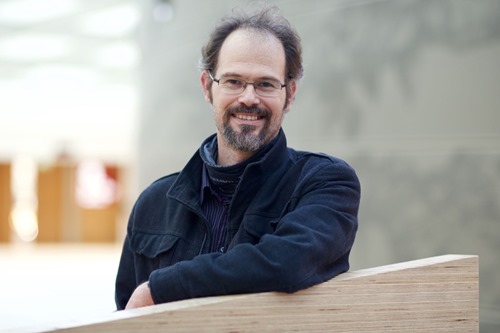“We need world-class talent” – Interview with Dr Sven Sewitz, Head of Biodata Innovation at Eagle Genomics
/potsdam__sciencepark-eagle_genomics-swen_sewitz__Eagle_Genomics.jpg)
Mr Sewitz, you are Head of Biodata Innovation at Eagle Genomics and want to open a new office in Germany. When will that be?
Actually, we wanted to have opened our office already on January 1st. Due to the Corona crisis, we had to postpone the date by a few months. We now hope that it will be mid-March. I have already been here with my family since autumn 2020 to set up our location in Germany.
How would you explain Eagle Genomics’ business model to a person who does not work in biotechnology?
We live in an age of data. We collect vast amounts of it and face the immense challenge of processing this data. The flood and complexity of data is now almost impossible to tame without data science and network science. This also applies to the field of biology. Example: In purely mathematical terms, there are more theoretical interaction possibilities between bacteria in the human intestine than there are atoms in the universe. And we had the impression that traditional methods of bioinformatics quickly reach their limits if you want to make clear statements from 1000-dimensional data sets that are also relevant to health.
And how does Eagle Genomics manage to process these huge amounts of data?
What we offer is a platform called e[datascientist]. It allows connections between data to be visualised, contextually assessed and explored via a user interface. This platform is a strategic part of the ‘digital transformation’ for many of our major clients.
Our focus here is on microorganisms. For example, our platform processes metagenomic data from large collections of bacteria found in the human gut, on the skin or in farmland soil. What we achieve with our platform is to systematise the innovation process and to facilitate and accelerate it many times over.
What does that mean in concrete terms? How can we imagine the platform?
To put it very simply: our platform manages to analyse these large amounts of data in advance and establish correlations with the help of artificial intelligence. This makes the evaluation much easier for our customers. For example, our customers can explore data and their connections in the “Exploration Module” without having to master their own “Graph Query Language”, i.e. a language for searching databases. They can then see, for example, within a few seconds, which genes are in which biological pathways, which reactions are catalysed by these pathways and which metabolites are consumed or produced. This “data exploration” can be carried out in any direction and can also be branched off in different directions. For example, you can also display diseases that are linked to these genes, so that you can continue your search from there with just a few mouse clicks.
What is the approach behind the platform?
We build our platform on modern graph databases, where you can not only explore existing connections, but increasingly also learn new connections using “graph inference”. This is where AI plays a big role in being able to draw new conclusions from existing data that are not apparent beforehand or to the naked eye.
In March you are now planning to move into your first German location in the Potsdam Science Park. Why did you want to open your office exactly here?
Potsdam and Berlin are known in Europe as cities that are at the forefront of driving innovation in the field of digitalisation. I’m thinking in particular of the Hasso Plattner Institute, but also of the German Institute of Human Nutrition, the Charité in Berlin, and of course especially the Fraunhofer-Gesellschaft and the research groups and companies that have settled in the Potsdam Science Park. At the same time, the large life science industry is strongly represented in Berlin, and there is a very international start-up culture.
All these aspects are important to us because we are a growing company. We need world-class talent. And we want our employees to work in an exciting and inspiring environment. Potsdam has the ideal mix of proximity to a cosmopolitan city, first-class research and a high quality of life. We see parallels to Cambridge, where our company was founded and where I worked in research for more than ten years.
Opening a new location during the Corona pandemic is a risky move. Why did the company take this risk?
There were several reasons. First, we want to expand our customer base on the European continent. Even in Corona times, it is better to be local and surround yourself with staff who know the local market better. Secondly, the situation in the UK is quite uncertain as far as post-Brexit regulations are concerned. Of course, we hope that the politicians will soon be able to remove all ambiguities, but we also see that this could take a while.
What does Eagle Genomics hope for from this new location in a new country?
We come to Germany with high expectations, but also with great joy. I’ve spent the past twenty years in England, and now I’m coming back to Germany with my eyes wide open and with great enthusiasm. The innovation landscape is very active here, and we want to be an active participant in it. We are concerned both with economic aspects, but just as strongly with new contacts in research. We firmly believe that a very exciting future can be forged in the area of tension between cutting-edge research, innovative applications and an expanding market.
Thank you very much for the interview.
This blog and the projects carried out by Standortmanagement Golm GmbH at Potsdam Science Park are funded by the European Regional Development Fund (ERDF) and the Federal State of Brandenburg. Photo Credit: Dr. Sven Sewitz © Eagle Genomics
/)

/potsdam-science-park_karen-esser_foto-martin-jehnichen_(1)_1.jpg)

/canvascolor(0xffffffff)/2018_08_14_Qatar_Qatar_Science_Park.jpg)
/canvascolor(0xffffffff)/2024_04_04_The_Netherlands_Lindholmen_Science_Park.jpg)
/canvascolor(0xffffffff)/PCT-GUAM_-LOGO-NORMAL_1.png)
/canvascolor(0xffffffff)/buildings2.png)
/canvascolor(0xffffffff)/2017_11_17_Taiwan_Southern_Taiwan_SP.png)
/canvascolor(0xffffffff)/QU_LOGO.png)
/canvascolor(0xffffffff)/2023_10_23_Sweden_Sandbacka_SP.jpg)
/canvascolor(0xffffffff)/2022_10_18_Luxembourg_Technoport.png)
/canvascolor(0xffffffff)/MemberLogo-5640-6065.jpg)
/canvascolor(0xffffffff)/Logo_SWPH_ohne_transparent.png)
/canvascolor(0xffffffff)/Andorra_RGB_RI-1_1.png)
/canvascolor(0xffffffff)/2021_03_17_China_Zhongguancun_Science_City.png)
/canvascolor(0xffffffff)/Identificador_Visual.png)
/canvascolor(0xffffffff)/ipm_logo_1@2x.jpg)
/canvascolor(0xffffffff)/2025_11_04_Saudi_Arabia_Dhahran_Techno_Valley.png)
/canvascolor(0xffffffff)/2017_11_13_UK_Coventry_Science_Park.jpg)
/canvascolor(0xffffffff)/logo-eng_4.png)
/canvascolor(0xffffffff)/MemberLogo-5751-6208.jpg)
/canvascolor(0xffffffff)/2024_05_08_Edmonton_Research_Park_Logo.png)
/canvascolor(0xffffffff)/House_of_BioHealth.png)
/canvascolor(0xffffffff)/Teknopark_vekt_rel_logo_page-0001_1.jpg)
/canvascolor(0xffffffff)/MemberLogo-59301-6100.jpg)
/canvascolor(0xffffffff)/2021_Spain_PCT__lava.png)
/canvascolor(0xffffffff)/2019_11_12_China_Tuspark_(Jiangsu).png)
/canvascolor(0xffffffff)/2017_07_25_Germany_Technologiepark_Heidelberg.jpg)
